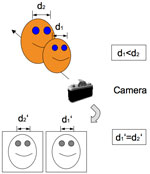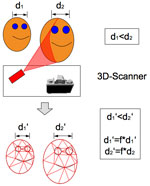



If you are asking yourself what biometrics actually is, the definition of the International Organization for Standardization might be helpful:
Automated recognition of individuals based on their behavioral and biological characteristics.
This basically means that a human being can be identified automatically by the way he behaves and looks like.
Criminalistic experts have been using biometric measures like finger print analysis for more than hundred years. At first, identiy has been determined by eye by experts. For some years computers have begun to aid the process and are able to determine the source of a fingerprint at a crime scene in only a few seconds.
But not only fingerprints are qualified for biometric recognition processes:
Iris or face images, the geometry of a human hand and much more features of the human body are already used in commercial systems and are not only used by criminalstic experts anymore.
While recognizing individuals by their biometric characteristics, an automatic authentication process can be realized that can then be used to offer an alternative method to conventional authenticationn methods like passwords,keys and tokens.
Finally, biometrics have become more important in the process of increasing security at border controls, where automatic recognition of individuals will gain a very important role.
To authenticate a person, their personal features are compared with reference data stored in a document, such as a secure travel document, or in a database. Biometric systems are either verification or identification systems. In the case of identification, the idea is to determine a person's identity, while the purpose of verification is to confirm a person's claimed identity.

The biometric recognition process consists of the following steps:
The whole process can only work, if every person is known to the system, eg. is trained (enrollment) to the system to gather necessary reference data.
The human itself uses face recognition most frequently to identify other persons. Besides, we check other biometric properties intuitively (like body height or shape) which a computer aided system can not use (at the moment).
Actual systems use cameras to take a front picture of the face. The resulting image is then processed by a recognition system. The first task is to filter the actual face from the image. This is not an easy task, as a change of hairstyle, beard or glasses can severely disturb the extraction process.
Therefore, certain predefined "landmarks" are deteced in the face of the image: These are characteristic positions in the face, like chin, egde points of eyes, corners of the mouth, etc.

Using such landmarks, systems can respond to rotations of the head.
Most important for 2D face recognition is good quality of image material: The face has to take about 70% of the space of the image, it has to be a frontal picture with high contrast, sharpness, illumination, a neutral expressione, no hiding of landmarks by eg. hair and glasses.
These criteria have to be met both in the production of the reference image as in the actual recognition process, which is very difficult. It is most unlikely that expression, illumination and contrast are the same in the photo studio and at a border control.
A further disadvantage is that 2D systems have no break fake resistance due to their nature. They can be easily fooled by presenting a simple print-out picture in front of the camera. Thus, in the near future, the process of border control has to be supervised by humans (border police officers).

To enable fully-automated border controls, it is therefore important to research on threedimensional systems for face recognition. You can for example use an active scan method which projects coloured bars onto the face and can thus extract depth information. Doing so, a complete 3D model of the scanned face can be modelled.
After modelling the face geometry, landmarks are detected, like in 2D channel, so that the 3D scans can be oriented in a normalized position. Then the reference model and scanned model can be properly compared.
Advantages in comparison to 3D technology are:
Although biometric systems are not yet wide-spread, every EU citizen will get in touch with such automatic systems in the next ten years, as new EU regulations will make biometric identification systems compulsive.
The move from 2D to 3D technology will then improve fake resistance and thus security. It will be very difficult to obtain even a 3D reference model of a human face - without cooperation of the subject. Producing an artificial head from such a model is even more difficult and can be detected by special liveness detection mechanisms.